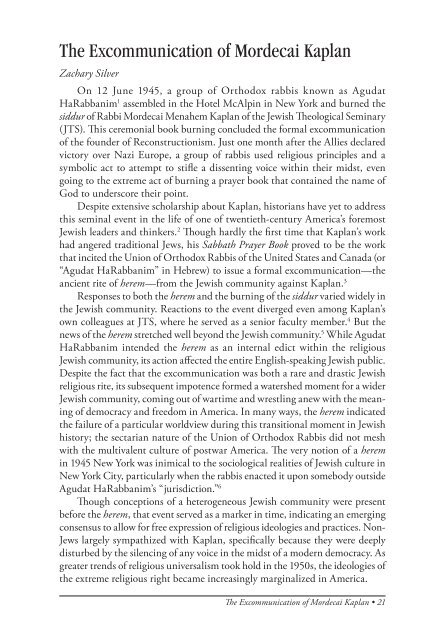American Jewish Archives Journal
American Jewish Archives Journal
American Jewish Archives Journal
Create successful ePaper yourself
Turn your PDF publications into a flip-book with our unique Google optimized e-Paper software.
The Excommunication of Mordecai Kaplan<br />
Zachary Silver<br />
On 12 June 1945, a group of Orthodox rabbis known as Agudat<br />
HaRabbanim1 assembled in the Hotel McAlpin in New York and burned the<br />
siddur of Rabbi Mordecai Menahem Kaplan of the <strong>Jewish</strong> Theological Seminary<br />
(JTS). This ceremonial book burning concluded the formal excommunication<br />
of the founder of Reconstructionism. Just one month after the Allies declared<br />
victory over Nazi Europe, a group of rabbis used religious principles and a<br />
symbolic act to attempt to stifle a dissenting voice within their midst, even<br />
going to the extreme act of burning a prayer book that contained the name of<br />
God to underscore their point.<br />
Despite extensive scholarship about Kaplan, historians have yet to address<br />
this seminal event in the life of one of twentieth-century America’s foremost<br />
<strong>Jewish</strong> leaders and thinkers. 2 Though hardly the first time that Kaplan’s work<br />
had angered traditional Jews, his Sabbath Prayer Book proved to be the work<br />
that incited the Union of Orthodox Rabbis of the United States and Canada (or<br />
“Agudat HaRabbanim” in Hebrew) to issue a formal excommunication—the<br />
ancient rite of herem—from the <strong>Jewish</strong> community against Kaplan. 3<br />
Responses to both the herem and the burning of the siddur varied widely in<br />
the <strong>Jewish</strong> community. Reactions to the event diverged even among Kaplan’s<br />
own colleagues at JTS, where he served as a senior faculty member. 4 But the<br />
news of the herem stretched well beyond the <strong>Jewish</strong> community. 5 While Agudat<br />
HaRabbanim intended the herem as an internal edict within the religious<br />
<strong>Jewish</strong> community, its action affected the entire English-speaking <strong>Jewish</strong> public.<br />
Despite the fact that the excommunication was both a rare and drastic <strong>Jewish</strong><br />
religious rite, its subsequent impotence formed a watershed moment for a wider<br />
<strong>Jewish</strong> community, coming out of wartime and wrestling anew with the meaning<br />
of democracy and freedom in America. In many ways, the herem indicated<br />
the failure of a particular worldview during this transitional moment in <strong>Jewish</strong><br />
history; the sectarian nature of the Union of Orthodox Rabbis did not mesh<br />
with the multivalent culture of postwar America. The very notion of a herem<br />
in 1945 New York was inimical to the sociological realities of <strong>Jewish</strong> culture in<br />
New York City, particularly when the rabbis enacted it upon somebody outside<br />
Agudat HaRabbanim’s “jurisdiction.” 6<br />
Though conceptions of a heterogeneous <strong>Jewish</strong> community were present<br />
before the herem, that event served as a marker in time, indicating an emerging<br />
consensus to allow for free expression of religious ideologies and practices. Non-<br />
Jews largely sympathized with Kaplan, specifically because they were deeply<br />
disturbed by the silencing of any voice in the midst of a modern democracy. As<br />
greater trends of religious universalism took hold in the 1950s, the ideologies of<br />
the extreme religious right became increasingly marginalized in America.<br />
The Excommunication of Mordecai Kaplan • 21
















